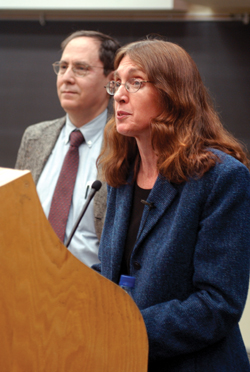
Beth Conklin, Ph.D., and Matthew Ramsey, Ph.D., spoke about the history of medical cannibalism. Photo by Dana Johnson
Felts Lecture: Cannabilism was once viewed as ‘eat to treat’
In 16th century Europe, your local medical doctor might have prescribed a preparation made from a human skull to treat epileptic seizures.
The seldom-discussed topic of medical cannibalism was the focus of Wednesday’s 10th Annual Philip W. Felts Lecture in the Humanities titled “Really alternative medicine: the therapeutic uses of cannibalism in history and culture.” The lecture honors Felts, the former associate dean of Student Affairs.
Two Vanderbilt scholars, Beth Conklin, Ph.D., associate professor of Anthropology and Religious Studies, and Matthew Ramsey, Ph.D., associate professor of History and director of Vanderbilt’s Center for Medicine, Health and Society discussed how cannibalism was actually a mainstream, socially-accepted part of Western culture.
“We are here today to talk about cases in which cannibalism was a socially-accepted practice in mainstream society and even considered healing to body or mind,” Conklin said. “In fact, the consumption of human body substance was once a valued part of our own Western medical tradition, a tradition that seems to have been largely forgotten when we think about the subject of cannibalism.”
According to Ramsey, it was common practice in early modern Europe for medical practitioners to prescribe preparations made from human parts for a variety of medical conditions, such as using bits of mummified flesh to heal wounds.
“European medicine did not ritually sacrifice living human beings in preparation of remedies. Patients did not dine on roasted thigh, despite the considerable overlap between culinary and pharmaceutical traditions. Human flesh, used medically, was in no sense, a meal. It was typically disguised in preparations that were indistinguishable from the other products of the apothecaries’ art,” Ramsey said.
Ramsey said such practices began to fall out of favor in the early 19th century for mainly scientific reasons.
Conklin, who has studied cannibalism in an Amazonian tribe called the Wari’, explained the different uses of cannibalism in tribal cultures, mainly as a ritual to ease grief from the loss of loved ones and to honor the memory of the dead relative.
Ramsey left the audience with some “food for thought” — perhaps our present day practices of organ transplantation and blood transfusions could be considered cannibalism.













